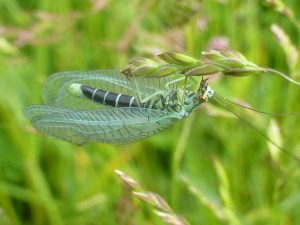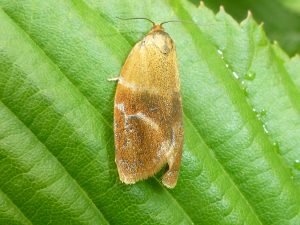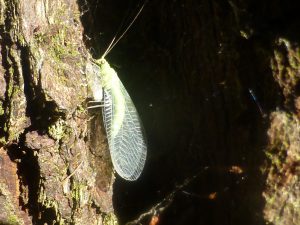The first half of June 2014 was rather unsettled with quite a lot of rain but the second half was much more settled and summery with some quite warm days. Even more species were added to the Edinburgh Garden’s wildlife list in June than in May — a total of 25, bringing the total up to 698.
Birds – By far the most exciting bird record in June was a Nuthatch heard calling from a tree in the vicinity trees of Inverleith House lawn (20th: see full story at http://stories.rbge.org.uk/archives/11832). This was of course a new Garden record, but one that had been expected for some time, ever since one was found dead in Stockbridge a couple of years ago by a friend of one of RBGE’s Garden Guides. A Fulmar that flew over on 21st was the first record for at least 25 years although it’s possible others have been overlooked as they nest in Holyrood Park. The month was rounded off by a Buzzard on 30th. Breeding records included Sparrowhawk (six eggs laid), and at least one surviving chick from the first Moorhen brood that hatched in May. The full list of bird species recorded at the Edinburgh Garden in June was: Blackbird, Blackcap, Black-headed Gull, Blue Tit, Bullfinch, Buzzard, Carrion Crow, Chaffinch, Chiffchaff, Coal Tit, Dunnock, Feral Pigeon, Fulmar, Goldcrest, Goldfinch, Great Spotted Woodpecker, Great Tit, Greenfinch, Grey Heron, Herring Gull, Jackdaw, Lesser Black-backed Gull, Long-tailed Tit, Magpie, Mallard, Mistle Thrush, Moorhen, Nuthatch, Robin, Rook, Song Thrush, Sparrowhawk, Stock Dove, Swallow, Swift, Tawny Owl, Tree Creeper, Willow Warbler, Wood Pigeon, Wren.
Insects – Five butterfly species were recorded during June. These included lots of Green-veined Whites and Small Whites while a single Large White on 9th was the first for at least seven years. Ringlets were flying in the Ecological Meadow in the second half of the month and a Red Admiral was reported on 8th. Brindled Twist was a new moth record for the Garden (5th). There were plenty of bumblebees and Honey Bees. Four species of solitary bee were recorded, and Edinburgh’s Wool Carder Bees began their 2014 season on 19th, the same date as last year; they were favouring the Stachys plantings around the Fruit Garden. None were seen in the Rock Garden, no doubt because the houseleeks that they tend to visit there had not started flowering. A male Common Hawker dragonfly was seen by the Pond (16th) while Azure Damselflies frequented the small pond in the Scottish Heath Garden on sunny days from 6th onwards. Eight different species of hoverfly were seen but as in May most were recorded on only one or two days – so far 2014 is not a vintage year for them. Three more fly species were added to the Garden’s list: Micropeza corrigiolata (12th), Herina nigrina (20th) and Rhagio lineola (25th).
Two species of green lacewing were seen, both of them being additions to the Garden’s insect fauna: Chrysopa perla on 6th and the Common Green Lacewing, Chrysoperla carnea, on 12th and 16th. A small brownish bug found on a birch catkin turned out, logically perhaps, to be Birch Catkin Bug Kleidocerys resedae, yet another new Garden record. Forest (Red-legged) Shield-bug and Hawthorn Shield Bug were both recorded but no other shield bug species were seen. Both ‘cuckoo spit’ and the similar ‘spittle’ formed by the Alder Spittlebug were recorded. Common Sycamore Aphid (Drepanosiphum platanoidis) and Silver Birch Aphid (Euceraphis betulae) were both new Garden records, as was the bug Cercopis vulnerata. The latter was found as remains in a spider web on the beech hedge and the normally bright red and black abdomen had faded somewhat to orangey-yellow and black. Two-spot and 7-spot ladybirds were recorded. Another two beetles were added to the Garden list, a soldier beetle and a weevil, both on 12th.
Leaf miners were much more evident in June than in May. Seventeen species of leaf-mining fly were recorded, with four of them being new Garden records, as well as ten leaf-mining moths (two being new Garden records). Twelve gall-forming mites were recorded on the leaves of various tree species, three of them being first records for the Garden, while galls formed by sawflies accounted for another three new Garden records, including two different species of Pontania on different species of willow.
Botanics Stories
RBGE Personal & Project Stories



